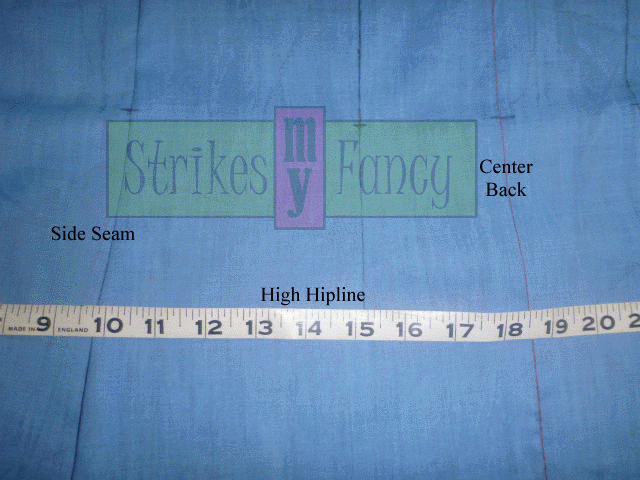Welcome back to Part 7: Fine Tuning the Sample~Making Corrections, in my pattern fitting series. It’s taken time, but if you’ve hung in there with me this far you should be happy about your progress. Once again, pattern fitting isn’t an easy proposition. It takes time, but if you stick with it, you can achieve Success!! If you’ve just found my blog and want to get started, check out my Pattern Fitting Series.
The first step in the analyzing process is to check your fitting sample measurements. Please check your bust, waist and high hip measurements. This is easily done by laying your fitting sample out on your work surface and measuring around at those specific points on your sample. No sense going forward with a fitting sample if the correct measurements don’t check out. This is where the seam allowance information from Part 5: Seam Allowances is very important, to maintain accuracy.
Center front to side seam at bustline.
Side seam to center back at bustline/back width.
Center front to side seam at waistline.
Side seam to center back at waistline.
Center front to side seam at high hipline.
Side seam to center back at high hipline.
If all the measurements check out, you’re now ready with your marked fitting sample to do the fine tuning. I want you to take your time with this step and really analyze your fitting sample because it’s important to me that you don’t feel disappointed in your efforts. Fitting isn’t always easy, however by following this series, you should be feeling more confident in your work. Try on your fitting sample in front of a mirror. Please have a hand mirror handy so you can check your back view for fit. It’s helpful to have a friend around, however it’s not necessary. Take your time with this step and be patient. If you’ve spent your time going through this whole series, this isn’t the time to get impatient with anything. At this point, do your best to pin the center front together and smooth the fabric into place.
These are pictures of the fitting sample I made for my dress form. This is how yours should fit.
* Notice how the shoulder slope and armhole are fitted but not tight? Still plenty of room for the sleeve to be attached.
* Notice how the darts skim the form but don’t pull? Still plenty of room to move with ease.

* Notice how the center front and center back marks don’t pull to either side but are straight.
* Notice how back neckline is smooth and skimming the form?
Time to analyze your fitting sample.
1. Are there places that are pulling?
2. Did the center front close well?
3. Is the apex in the correct position?
4. If you have a bust dart, is it in the proper position?
5. Is your waistline marking at your waistline?
6. How does your shoulder slope fit?
7. Is your shoulder point in the correct position?
8. How does your high hip fit?
9. Are the center front and center back lines straight in the center?
10. Is your armhole pulling or gaping?
11. Is the neckline pulling or gaping?
12. Is the back smooth at the neck and shoulders?
13. Is there enough width across the back shoulders?
14. Is the waistline too snug or too loose?
How to pin fix fitting sample issues:
Any fitting issues you might encounter at this point should be very minor. Our bodies have dimension and shape so tweaking the fitting sample here and there to accommodate our curves may be necessary. If you’ve measured properly, applied those measurements to your pattern and checked your fitting sample measurements before you tried the sample on, you should be very close to a comfortable fit. Please keep in mind that I’ve simulated these fitting corrections. I didn’t actually have these issues with my fitting sample, but you may encounter these so I wanted to show you how to fix them.
Gaping front armhole: This is a simple fix by pinning out a small wedge of fabric and transferring it to the bust dart. Please keep in mind that it shouldn’t fit tightly. You will be adding a sleeve to this armhole and it’s important to have enough ease for the sleeve. If your pattern doesn’t have a sleeve, then you may fit the armhole more closely to the body as well as raise the armhole at the side seam. If you end up with a very large wedge, then your length measuring wasn’t done correctly and applied to your pattern properly.
Removing a small wedge at the armhole because it was gaping.
Transferring dart correction.
Shoulder slope to high: You don’t want your shoulder slope to be at such a severe slope that you won’t have enough room too add a sleeve. Keep in mind that your armhole should be moderately loose all the way around your armhole. By adding your sleeve, it will automatically be pulled in by the stitching line slightly.
Lowering your shoulder slope.
Smoothing back neckline: This is a common fitting issue if your back is very shaped at the top of your spine. I had suggested that those of you with this challenge use a pattern with a center back seam or a yolk because it easiest to make the appropriate correction on those patterns. If you did use a pattern with a center back seam simply take out the bit at the center back neckline down to nothing. If you have a yoke, then take out the bit by overlapping the wedge out of the neckline to nothing. If you didn’t use one of those types of patterns, remove the extra by easing it in around the back neckline for a comfortable fit. If it’s just a small amount, the easing may be enough without making changes to your pattern. If you do make changes to a center back seam, pinch out of your yoke at the neckline, or ease in your back neckline then make sure you make corrections to your collar, collar stand or facings that coincide with the back neckline.

Removing a small amount at the center back neckline.
Waistline to snug or loose: Let out or remove a bit from the front and back darts to accommodate your waist line with a better fit. You may also take in a bit more in your front and back darts. This may be a better choice depending on your shape. Remember the same is also true if you need to let out a dart to add a little more room. Make sure to close the dart and true the side seam and then transfer corrections to the back of your bodice side seam.
Taking is a little bit at the side seams.
Side seam and dart correction.
How to transfer corrections to your pattern:
If you’re satisfied with your pin fitting, mark where the pins are located with pencil. Now take apart the basting stitches in any area you made fitting corrections so you can lay the fitting sample flat on your pattern. True all correction lines and trace those lines with either a regular tracing wheel or a needle point tracing wheel. This is the best and most accurate way to transfer corrections from your fitting sample back to your paper pattern.
How to fit sleeve after bodice is fitted properly:
Walking the sleeve pattern around your bodice armhole of your pattern is an important method in checking the fit of any sleeve. This is done after you’ve checked your sleeve against your measurements and made any alterations earlier to coincide with armhole corrections. For example shoulder slope or shoulder length changes. Also if side seam alterations were made earlier as well. Basically any changes made to the bodice pattern regarding the armhole of the pattern.
Checking the fit of your sleeve is done by laying your sleeve pattern on top of your front bodice pattern at the side seam/under arm seam. Slowly walk the sleeve pattern around the armhole while pivoting with a pencil at the seam line.
Make sure your front and back notches match as you walk the sleeve around the armhole.
Continue with your pencil to pivot at the seam line of your sleeve around the seam line of your bodice until you get to the shoulder point seam line. Make a mark on your sleeve pattern piece when you get to that point.
Now repeat this process again with the back of the sleeve at the seam line on the back of the armhole at the seam line. Once again make a mark on your sleeve pattern piece at the shoulder point of the back armhole.
The amount between these two markings is very important. It should be between 3/4″ to 1 1/4″. This is the amount of ease in the sleeve cap that must be eased into the armhole of the bodice. My pattern had 7/8″ ease in the sleeve cap. The small circle on the sleeve pattern indicates where the sleeve should attach to the shoulder seam. This should always be slightly forward in the ease so the sleeve hangs properly towards the front of the garment.
Thanks once again for all the support, messages and comments. I hope this series has been helpful!! Only one more week and then I will be selecting the winner of my Give-Away!! Good Luck!!
























My muslin FITS! Thank you for this series!
Thanks Great!! Thanks for commenting!!
This is an awesome series, thank you
Hi Bec!! You're Welcome!! Thanks so much for the AWESOME compliment!!
Help, I've got gaping armholes, both front and back. My pattern doesn't have front darts. Do I add some to fix it? My front measurement is correct, but by front to apex is off on my pattern. How should I alter it?